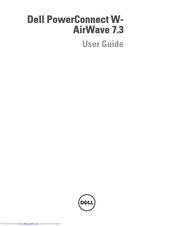Dell PowerConnect W-AirWave 7.3 Manuals
Manuals and User Guides for Dell PowerConnect W-AirWave 7.3. We have 4 Dell PowerConnect W-AirWave 7.3 manuals available for free PDF download: User Manual, Manual, Quick Start Manual
Advertisement
Dell PowerConnect W-AirWave 7.3 Manual (48 pages)
W-Airwave 7.3 Best Practices Guide
Table of Contents
Advertisement
Dell PowerConnect W-AirWave 7.3 Quick Start Manual (5 pages)
W-Airwave 7.3 Quick Start Guide
Advertisement
Related Products
- Dell OPENMANAGE 7.6
- Dell PowerConnect W-AirWave 7.4
- Dell PowerQuest DataKeeper PowerVault 701N/705N Edition
- Dell Server Administrator 7.2
- Dell PowerConnect W Airwave 7.1
- Dell PowerConnect W-Airwave Wireless Management Suite
- Dell PowerConnect W-AirWave 7.5
- Dell PowerConnect W AirWave 7.2
- Dell PowerConnect W-AirWave 7.2
- Dell 7330dn - Laser Printer B/W



